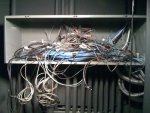Pat,
I actually agree with Ivan. Patching a graphic to a channel insert is a trick I use quite a bit to expand the eq control of lower end boards. Looking back at the photos I can see that the 15 band eqs had already been zeroed out because the one I wasn't using is flat. This was a corner stage that was pretty small. I basically set up my gains on the board and had the board pretty flat and the system did not have any feedback until I introduced the musicians. Then three of the instrument condensers (on the outside corners) started feeding back like crazy. Because I had no where to go on the house graph, I was forced to make due on the inserts, which was actually better than making due just on the board eqs. Given that the only bands that were even close to 0 were 80-120 and everything over 12k on the house graph, it may be that the head house tech (who wasn't present at the show) was trying to correct something that should have been corrected at the crossover.
On shows where I have had an opener doing a one mic setup before the main band which was using close mics, if I am on my own system I tend to save different eq setups on my processor, When I am one someone elses rig, I just insert an eq on the one mic channel.
The real oddball thing was the total amount of cut and then makeup gain used in three separate places of the signal chain (board, insert, output eq). I never did see the crossovers. I am not really sure I wanted to.

